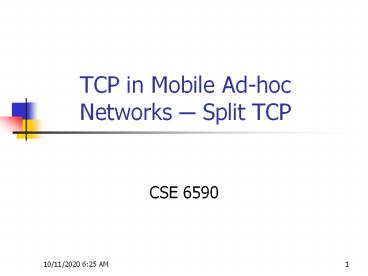TCP in Mobile Ad-hoc Networks - Split TCP PowerPoint PPT Presentation
Title: TCP in Mobile Ad-hoc Networks - Split TCP
1
TCP in Mobile Ad-hoc Networks - Split TCP
- CSE 6590
2
Overview
- What is TCP?
- TCP challenges in MANETs
- TCP-based solutions
- Split-TCP
- ATCP
3
TCP A Brief Review
- TCP Transmission Control Protocol
- Specified in 1974 (TCP Tahoe)
- Data stream ? TCP packets
- Reliable end-to-end connection
- In-order packet delivery
- Flow and congestion control
4
How does TCP work?
- Establishes an end-to-end connection
- Acknowledgement based packet delivery
- Assigns a congestion window Cw
- Initial value of Cw 1 (packet)
- If trx successful, congestion window doubled.
Continues until Cmax is reached - After Cw Cmax, Cw Cw 1
- If timeout before ACK, TCP assumes congestion
5
How does TCP work? (2)
- TCP response to congestion is drastic
- A random backoff timer disables all transmissions
for duration of timer - Cw is set to 1
- Cmax is set to Cmax / 2
- Congestion window can become quite small for
successive packet losses. - Throughput falls dramatically as a result.
6
TCP Congestion Window
7
Why does TCP perform badly in MANETs?
- Dynamic network topology
- Node mobility
- Network partition
- Multi-hop paths
- Variable path lengths
- Longer path higher failure rate
8
Why does TCP struggle in MANETs? (2)
- Lost packets due to high BER (Bit Error Rate)
- BER in wired 10-8 10-10
- BER in wireless 10-3 10-5
9
Solutions for TCP in MANETs
- Various solutions present
- Most solutions generally tackle a subset of the
problem - Often, fixing one part of TCP breaks another part
- Competing interests exist in the standards laid
out by OSI
10
Solution Topology
11
Why focus on TCP-based solutions?
- We want to choose solutions which maintain close
connection to TCP - Upper layers in the OSI model affected by choice
of transport layer protocol - Modifications may affect interactions with the
Internet - Alternative methods only useful for isolated
networks
12
Solutions for TCP
13
Split-TCP and ATCP
14
TCP Summary
- Works well in wired
- Fails in wireless networks due to frequent
connection breaks - Mobile nodes move
- Packets lost due to lossy channels
- Multi-hop paths more prone to failure
- Present solutions tackle subset of problems
- Two solutions Split-TCP and ATCP
15
Split-TCP Overview
- Motivation for Split-TCP
- How does Split-TCP work?
- Advantages/Disadvantages
- Performance Evaluation
- Throughput vs. TCP
- Channel Capture Effect
- Summary
16
Split-TCP in Solution Topology
17
Motivation for Split-TCP
- Issues addressed by Split-TCP
- Throughput degradation with increasing path
length - Channel capture effect (802.11)
- Mobility issues with regular TCP
18
Channel Capture Effect
- Definition
- The most data-intense connection dominates the
multiple-access wireless channel 1 - Higher SNR
- Early start
- Example 2 simultaneous heavy-load TCP flows
located close to each other.
19
How does Split-TCP work?
- Connection between sender and receiver broken
into segments - A proxy controls each segment
- Regular TCP is used within segments
- Global end-to-end connection with periodic ACKs
(for multiple packets)
20
Split-TCP Segmentation
21
Split-TCP in a MANET Proxy Functionality
- Proxies
- Intercept and buffer TCP packets
- Transmit packet, wait for LACK
- Send local ACK (LACK) to previous proxy
- Packets cleared upon reception of LACK
- Increase fairness by maintaining equal connection
length
22
Split-TCP in a MANET (2)
- Steps
- Node 1 initiates TCP session
- Nodes 4 and 13 are chosen as proxies on-demand
- Upon trx, 4 buffers packets
- If a packet lost at 15, request made to 13 to
retransmit - 1 unaware of link failure at 15
23
Split-TCP in a MANET (3)
- Sender is unaware of transient link failure.
Congestion window not reduced. - Packet retransmissions only incorporate part of a
path ? bandwidth usage is reduced. - Channel capture effect is alleviated (see next
slide).
24
Channel capture alleviated
25
Is Split-TCP successful?
- Pros
- Increased throughput
- Increased fairness
- Restricted channel capture effect
- Cons
- Modified end-to-end connection
- Proxy movement/failure adversely affects protocol
performance - Congestion at proxy nodes if another fails
26
Performance Evaluation
- Test bench Specifics
- ns-2 Simulator
- 50 mobile nodes initially equidistant
- 1 km2 Area
- Nodes maintain constant velocity
- Arbitrary direction
- Random changes at periodic intervals
- Optimal segment length 3 n 5 nodes
- Measured improvement Throughput increases by 5
to 30
27
Performance vs. TCPThroughput Comparison
28
Performance vs. TCPChannel Capture Effect
Regular TCP Throughput
Split-TCP Throughput
29
Split-TCP Summary
- Break link into segments with proxies
- Use proxies to buffer packets at segments
- Employ TCP locally in segments
- Reduce bandwidth consumption and channel capture
effect
30
Issues Not Addressed
- Does not maintain end-to-end semantics
- Periodic ACK failures means major retransmissions
- Packet loss due to high BER
- Out-of-order packets
- Proxy link failure affects performance
31
References
- 1 Split-TCP for Mobile Ad Hoc Networks
Kopparty et al. - 2 ATCP TCP for Mobile Ad Hoc Networks Jian
Liu, Suresh Singh, IEEE Journal, 2001. - 3 A Feedback-Based Scheme for Improving TCP
Performance in Ad Hoc Wireless Networks Kartik
Chandran et al. - 4 Ad Hoc Wireless Networks Architectures and
Protocols C. Siva Ram Murthy and B. S. Manoj
section 9.5.7. - 5 Improving TCP Performance over Wireless
Networks Kenan Xu, Queens University 2003.

